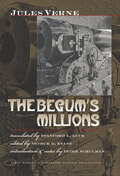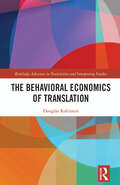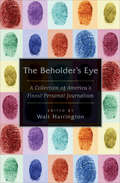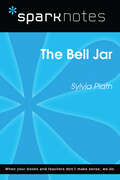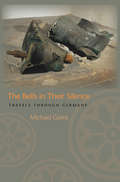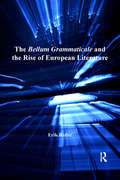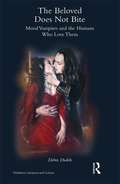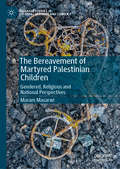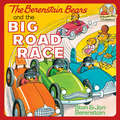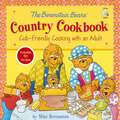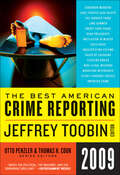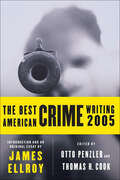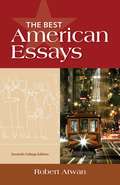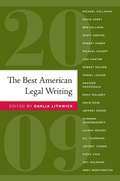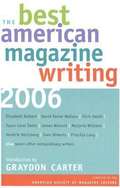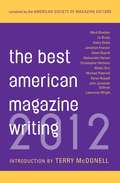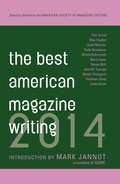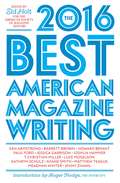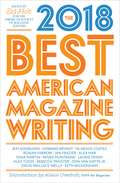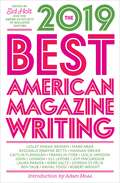- Table View
- List View
The Begum's Millions: Extraordinary Voyages #18 (Early Classics of Science Fiction)
by Jules VerneVerne's first cautionary tale about the dangers of science — first modern and corrected English translation. When two European scientists unexpectedly inherit an Indian rajah's fortune, each builds an experimental city of his dreams in the wilds of the American Northwest. France-Ville is a harmonious urban community devoted to health and hygiene, the specialty of its French founder, Dr. François Sarrasin. Stahlstadt, or City of Steel, is a fortress-like factory town devoted to the manufacture of high-tech weapons of war. Its German creator, the fanatically pro-Aryan Herr Schultze, is Verne's first truly evil scientist. In his quest for world domination and racial supremacy, Schultze decides to showcase his deadly wares by destroying France-Ville and all its inhabitants. Both prescient and cautionary, The Begum's Millions is a masterpiece of scientific and political speculation and constitutes one of the earliest technological utopia/dystopias in Western literature. This Wesleyan edition features notes, appendices, and a critical introduction as well as all the illustrations from the original French edition.
The Behavioral Economics of Translation (Routledge Advances in Translation and Interpreting Studies)
by Douglas RobinsonThis book applies frameworks from behavioral economics to Western thinking about translation, mapping four approaches to eight keywords in translation studies to bring together divergent perspectives on the study of translation and interpreting. The volume takes its points of departure from the tensions between the concerns of behavioral and neoclassical economists. The book considers on one side behavioral economists’ interest in the predictable irrationality of “Humans” and its nuances as they unfold in terms of gender, here organized around Masculine Human, Feminine Human, and Queer perspectives, and on the other side neoclassical economists’ chief concerns with the unfailing rationality of the “Econs.” Robinson applies these four approaches across eight chapters, each representing a keyword in the study of translation—agency; difference; Eurocentrism; hermeneutics; language; norms; rhetoric; and world literature—with case studies that problematize the different categories. Taken together, the book offers a comprehensive treatment of the behavioral economics of translation and promotes new ways of thinking in the study of translation and interpreting, making it of interest to scholars in the discipline as well as those working along interdisciplinary lines in related fields such as philosophy, literature, and political science.
The Beholder's Eye: A Collection of America's Finest Personal Journalism
by Scott Anderson Harry Crews Mary Kay BlakelyA collection of the very best in contemporary first-person journalism compiled by the award-winning former Washington Post reporter and author.Great journalists, at one time or another, have all been characters in their own stories: people with personalities that shaped what they saw and reported, and were touched and changed by the experiences about which they wrote; and innovators who borrowed the storytelling techniques of fiction. The Beholder’s Eye showcases the very best of an increasing trend toward personal narrative: Mike Sager stalking Marlon Brando in the Tahitian jungle; J. R. Moehringer’s quest to discover the true identity of an old boxer; Bill Plaschke’s story about a woman with cerebral palsy who runs an obscure Los Angeles Dodgers Web site; Scott Anderson’s story of his lifetime of covering war after war; Harrington’s own tale of his interracial family’s struggle to persevere; and many others. Written by reporters who were willing to reveal themselves in order to bring readers insights that were deeper than supposedly objective third-person stories, their articles are an invaluable resource for aspiring journalists, students, and teachers of the craft of writing, and any reader with an appreciation for masterful storytelling.“Aims to dispel the old journalistic cliché: that a journalist writing about him/herself is always ‘self-indulgent and, quite likely, narcissistic.’ He couldn’t have put together a better lineup of writers to make the point that it doesn’t have to be . . . Not just some of the country’s finest personal journalism, but some of its finest journalism, period.”—Kirkus Reviews
The Bell Jar (SparkNotes Literature Guide Series)
by SparkNotesThe Bell Jar (SparkNotes Literature Guide) by Sylvia Plath Making the reading experience fun! Created by Harvard students for students everywhere, SparkNotes is a new breed of study guide: smarter, better, faster.Geared to what today's students need to know, SparkNotes provides:chapter-by-chapter analysis explanations of key themes, motifs, and symbols a review quiz and essay topicsLively and accessible, these guides are perfect for late-night studying and writing papers.
The Bells in Their Silence: Travels through Germany
by Michael GorraNobody writes travelogues about Germany. The country spurs many anxious volumes of investigative reporting--books that worry away at the "German problem," World War II, the legacy of the Holocaust, the Wall, reunification, and the connections between them. But not travel books, not the free-ranging and impressionistic works of literary nonfiction we associate with V. S. Naipaul and Bruce Chatwin. What is it about Germany and the travel book that puts them seemingly at odds? With one foot in the library and one on the street, Michael Gorra offers both an answer to this question and his own traveler's tale of Germany. Gorra uses Goethe's account of his Italian journey as a model for testing the traveler's response to Germany today, and he subjects the shopping arcades of contemporary German cities to the terms of Benjamin's Arcades project. He reads post-Wende Berlin through the novels of Theodor Fontane, examines the role of figurative language, and enlists W. G. Sebald as a guide to the place of fragments and digressions in travel writing. Replete with the flaneur's chance discoveries--and rich in the delights of the enduring and the ephemeral, of architecture and flood--The Bells in Their Silence offers that rare traveler's tale of Germany while testing the very limits of the travel narrative as a literary form.
The Bellum Grammaticale and the Rise of European Literature
by Erik ButlerThe now-forgotten genre of the bellum grammaticale flourished in the sixteenth- and seventeenth centuries as a means of satirizing outmoded cultural institutions and promoting new methods of instruction. In light of works written in Renaissance Italy, ancien régime France, and baroque Germany (Andrea Guarna's Bellum Grammaticale [1511], Antoine Furetière's Nouvelle allégorique [1658], and Justus Georg Schottelius' Horrendum Bellum Grammaticale [1673]), this study explores early modern representations of language as war. While often playful in form and intent, the texts examined address serious issues of enduring relevance: the relationship between tradition and innovation, the power of language to divide and unite peoples, and canon-formation. Moreover, the author contends, the "language wars" illuminate the shift from a Latin-based understanding of learning to the acceptance of vernacular erudition and the emergence of national literature.
The Beloved Does Not Bite: Moral Vampires and the Humans Who Love Them (Children's Literature and Culture)
by Debra DudekIn this new monograph, author Debra Dudek defines a new era of vampire texts in which vampires have moved from their iconic dark, feared, often seductive figure lingering in alleys, to the beloved and morally sensitive vampire winning the affections of teen protagonists throughout pop culture. Dudek takes a close look at three hugely-popular vampire series for young adults, drawing parallels between the TV series Buffy the Vampire Slayer, the Twilight Saga novels/films, and The Vampire Diaries TV series/book series. By defining a new era of vampire texts and situating these three series within this transition, The Beloved Does Not Bite signals their significance and lays the groundwork for future scholarship on the flourishing genre of paranormal romances for young adults.
The Beneficiary
by Bruce RobbinsFrom iPhones and clothing to jewelry and food, the products those of us in the developed world consume and enjoy exist only through the labor and suffering of countless others. In his new book Bruce Robbins examines the implications of this dynamic for humanitarianism and social justice. He locates the figure of the "beneficiary" in the history of humanitarian thought, which asks the prosperous to help the poor without requiring them to recognize their causal role in the creation of the abhorrent conditions they seek to remedy. Tracing how the beneficiary has manifested itself in the work of George Orwell, Virginia Woolf, Jamaica Kincaid, Naomi Klein, and others, Robbins uncovers a hidden tradition of economic cosmopolitanism. There are no easy answers to the question of how to confront systematic inequality on a global scale. But the first step, Robbins suggests, is to acknowledge that we are, in fact, beneficiaries.
The Bereavement of Martyred Palestinian Children: Gendered, Religious and National Perspectives (Palgrave Studies in Cultural Heritage and Conflict)
by Maram MasarwiThis book examines the phenomenon of individual and collective bereavement in Palestinian society. It seeks to explore the boundaries of the discourse of bereavement and commemoration in that society through the interactive relations between religion, nationality and gender, and the ways these influence the shaping of the mourning process for Palestinian parents who have lost their children in the second (al-Aqsa) Intifada. Over the course of the book’s five chapters, Maram Masarwi scrutinizes how these components have shaped the differences in behavior between bereaved fathers and bereaved mothers: what characterizes these differences, how they are expressed, and how they have managed to shape the characteristics of the experience of Palestinian bereavement.
The Berenstain Bears and the Big Road Race (First Time Books(R))
by Stan Berenstain Jan Berenstain"Over, under, around and through went Orange, Yellow, Green and Blue", but Brother Bear in his little red car slowly but surely wins out in this tortoise-and-hare story. Full-color illustrations. Copyright © Libri GmbH. All rights reserved.
The Berenstain Bears' Country Cookbook: Cub-Friendly Cooking with an Adult (Berenstain Bears/Living Lights: A Faith Story)
by Mike BerenstainIf your family is a fan of the Berenstain Bears or you are searching for a kid-friendly cookbook, The Berenstain Bears&’ Country Cookbook will be a family favorite. With 40 easy-to-follow recipes, your kiddos will enjoy making dishes for breakfast, lunch, dinner, and dessert. This cookbook is perfect for ages 4 to 8 and is filled with fun for the whole family. Inside you&’ll find:40 recipes (10 recipes for each section: breakfast, lunch, dinner, and dessert)Fun ways to incorporate grace before each mealSweet facts about honeyKitchen measurement conversionsCooking is a great way for children to develop cognitive skills and abilities. With step-by-step directions and delicious recipes, this kid-friendly cookbook teaches children of all ages how to:Apply knowledge of math, science, and languageFollow instructions and solve problemsMake predictions and observationsThe Berenstain Bears&’ Country Cookbook is an addition to The Living Lights™ series:Features the hand-drawn artwork of the Berenstain familyThis Berenstain Bears series of books continues in the much-loved footsteps of Stan and Jan BerenstainIs part of one of the bestselling children&’s book series ever created, with more than 250 books published and nearly 300 million copies sold to date
The Best American Crime Reporting 2009 (The Best American Series)
by Jeffrey Toobin, Otto Penzler and Thomas H. Cook“With consistently interesting content and beautiful writing, this collection will be devoured by fans of true crime and narrative nonfiction.” —Library JournalEdited by Jeffrey Toobin, CNN’s senior legal analyst and New York Times–bestselling author of The Nine, The Best American Crime Reporting 2009 is a must-have for the true crime reader, complete with the most gripping, suspenseful, and brilliant stories of the year by the masters of crime reporting. Featuring stories of fraud, murder, theft, and madness, the Best American Crime Reporting series has been hailed as “arresting reading” (People) and the best mix of “the political, the macabre, and the downright brilliant” (Entertainment Weekly).
The Best American Crime Writing 2005 (The Best American Series)
by James Ellroy“One of the strengths of this true-crime anthology series comes simply from its astonishing variety . . . it would be tough to better this collection.” —BooklistThe 2005 edition of The Best American Crime Writing offers the year’s most shocking, compelling, and gripping writing about real-life crime, including Peter Landesman’s article about female sex slaves (the most requested and widely read New York Times story of 2004), a piece from The New Yorker by Stephen J. Dubner (the coauthor of Freakanomics) about a high-society silver thief, and an extraordinarily memorable “ode to bar fights” written by Jonathan Miles for Men’s Journal after he punched an editor at a staff party. But this year’s edition includes a bonus—an original essay by James Ellroy detailing his fascination with Joseph Wambaugh and how it fed his obsession with crime—even to the point of selling his own blood to buy Wambaugh’s books. Smart, entertaining, and controversial, The Best American Crime Writing is an essential edition to any crime enthusiast’s bookshelf.“Great choices [and] great writing . . . proves truth is indeed stranger than fiction.” —Bloomberg News“Because these well-written articles vary widely, this work should appeal to all true-crime enthusiasts.” —Library Journal“A solid and diverse collection of true-crime writing . . . Anyone interested in true crime should find something to enjoy in this wide-ranging collection.” —Publishers Weekly
The Best American Essays, College Edition (Seventh Edition)
by Robert AtwanThis version of The Best American Essays is designed for college students and classroom use. The selection is based on length, topicality, diverse perspectives, and rhetorical and thematic variety. The book reflects the types of writing most often taught in introductory and even advanced composition courses. Suitable for various writing courses, it can be used in mainstream freshman composition programs with a focus on personal, expository, and argumentative essays.
The Best American Legal Writing 2009
by Dahlia LithwickThe Best American Legal American Writing 2009 introduces readers to the most informative and incisive writing on the subject of legal theory and practice published during the past year.
The Best American Magazine Writing 2004
by American Society of Magazine StaffThis stunning collection of features, essays, profiles, and reportage is comprised of all the winners and finalists for this year's National Magazine Awards.
The Best American Magazine Writing 2005
by American Society of Magazine EditorsIn the magazine world, no recognition is more highly coveted or prestigious than a National Magazine Award. Annually, members of the American Society of Magazine Editors in association with the Columbia University Graduate School of Journalism select the year's most dynamic, original, provocative, and influential magazine stories. The winning and finalist pieces in this anthology represent outstanding work by some of the most eminent writers in America as well as rising literary and journalistic talents.This collection celebrates excellence in several genres: investigative reporting, features, profiles, criticism, and essays. The stories cover a variety of subjects from Seymour Hersh's investigation into abuse at Abu Ghraib prison and Samantha Power's account of the genocide in Darfur to Ned Zeman's remarkable portrait of Timothy Treadwell, the man who lived with grizzlies, and David Kamp's piece on the extraordinary collaboration between Rick Rubin and Johnny Cash. Other pieces include Chris Jones on life at the International Space Station, James McManus on stem-cell research, Adam Gopnik on Times Square, Jed Perl on the redesign of the Museum of Modern Art, David Quammen on disputes about evolution, and James Wolcott on the blogosphere.Wide-ranging in their style and subjects, these pieces inform, surprise, entertain, and provide new perspectives on our world. They also reflect elements that distinguish the best in magazine writing: moral passion, investigative zeal, vivid characters and settings, persistent reporting, and artful writing.
The Best American Magazine Writing 2006
by American Society of Magazine EditorsIn the magazine world, no recognition is more highly coveted or prestigious than a National Magazine Award. Annually, members of the American Society of Magazine Editors, in association with the Columbia University Graduate School of Journalism, select the year's most dynamic, original, provocative, and influential magazine stories. The winning and finalist pieces in this anthology represent outstanding work by some of the most eminent writers in America as well as rising literary and journalistic talents. This collection celebrates excellence in investigative reporting, features, profiles, criticism, and essays. The stories cover a variety of subjects from Elizabeth Kolbert's investigation into global warming and Mimi Swartz's look at tort reform in Texas to Chris Heath's remarkable profile of Merle Haggard and David Samuel's brilliant piece on how Yasir Arafat destroyed Palestine. Other writers include James Fallows, David Foster Wallace, Marjorie Williams, Hendrik Hertzberg, Joyce Carol Oates, Sven Birkerts, Alex Wilkinson, and Priscilla Long. Wide-ranging in their style and subjects, these writers' stories inform, surprise, entertain, and provide new perspectives on our world. They also reflect elements that distinguish the best in magazine writing: moral passion, investigative zeal, vivid characters and settings, persistent reporting, and artful writing.
The Best American Magazine Writing 2012
by American Society of Magazine EditorsChosen from the 2012 National Magazine Awards finalists and winners, this anthology is filled with compelling features and profiles, eye-opening reporting, and incisive criticism and analysis of contemporary culture and society. Written by today's leading journalists, the selections cover a range of developments in politics, international affairs, culture, and business--from the increasingly short shelf lives of celebrity marriages to the ongoing fallout from Wall Street's financial malpractice, from the insidious effects of the lingering wars in Iraq and Afghanistan to the resurgent battle over issues pertaining to women's safety and health. Always engaging and informative, Best American Magazine Writing 2012 is an incomparable resource for the most noteworthy journalism and literary achievements of the year.<P><P> Essays include Lawrence Wright (The New Yorker) on the history of Scientology and recent challenges to its mission and methods; Matthieu Aikins (The Atlantic) on the shady dealings and shifting sands of the war in Afghanistan; the late Christopher Hitchens (Vanity Fair) on the physical and emotional toll of cancer; and Joel Stein (Time) on the propensity for politicians and other popular figures to get into trouble on the Internet. John Jeremiah Sullivan (GQ) immerses himself in David Foster Wallace's curious legacy; Tim Crothers (ESPN) follows the inspiring story of Phiona Mutesi, a chess prodigy from the slums of Uganda; Chris Ballard (Sports Illustrated) recounts Dewayne Dedmon's struggle to reconcile his faith with a career in sports; Wesley Yang (New York) explores the pressure on Asian Americans to succeed and the psychological and cultural consequences when they don't; and Luke Dittrich (Esquire) shares the raw experiences of those who survived one of 2011's worst natural disasters: the tornado that hit Joplin, Missouri. The sparkling dialogue and vividly imagined, eccentric characters of Karen Russell's award-winning short story, "The Hox River Window" (Zoetrope: All-Story), rounds out the collection.
The Best American Magazine Writing 2013
by American Society of Magazine EditorsChosen by the American Society of Magazine Editors, the stories in this anthology include National Magazine Award–winning works of public interest, reporting, feature writing, and fiction. This year's selections include Pamela Colloff (Texas Monthly) on the agonizing, decades-long struggle by a convicted murderer to prove his innocence; Dexter Filkins (The New Yorker) on the emotional effort by an Iraq War veteran to make amends for the role he played in the deaths of innocent Iraqis; Chris Jones (Esquire) on Robert A. Caro's epic, ongoing investigation into the life and work of Lyndon Johnson; Charles C. Mann (Orion) on the odds of human beings' survival as a species; and Roger Angell (The New Yorker) on aging, dying, and loss. The former infantryman Brian Mockenhaupt (Byliner) describes modern combat in Afghanistan and its ability both to forge and challenge friendships; Ta-Nehisi Coates (The Atlantic) reflects on the complex racial terrain traversed by Barack Obama; Frank Rich (New York) assesses Mitt Romney's ambiguous candidacy; and Dahlia Lithwick (Slate) looks at the current and future implications of an eventful year in Supreme Court history. The volume also includes an interview on the art of screenwriting with Terry Southern from The Paris Review and an award-winning short story by Stephen King published in Harper's magazine.
The Best American Magazine Writing 2014
by American Society of Magazine EditorsOur annual anthology of finalists and winners of the National Magazine Awards 2014 includes Max Chafkin's oral history of Apple from Fast Company, Joshua Davis's intimate portrait of tech pioneer John McAfee's personal and public breakdown from Wired; Kyle Dickman's haunting investigation into the preventable death of nineteen firemen battling an Arizona wildfire; and Ariel Levy's emotional account of extreme travel to a remote land—while pregnant—from The New Yorker.Other essays include Wright Thompson's bittersweet profile of Michael Jordan's fifty-something second act (ESPN the Magazine); Jean M. Twenge's revealing look at fertility myths and baby politics (The Atlantic); Janet Reitman's controversial study of the Boston Marathon bomber Dzhokhar Tsarnaev (Rolling Stone); Luke Mogelson's harrowing experience accompanying asylum seekers on a potentially deadly sea voyage to Australia (New York Times Magazine); Lisa Miller's poignant report from Newtown, Connecticut, as the town tries to cope with the aftermath of one of the nation's worst mass shootings (New York); Emily Nussbaum's critiques of gender and politics on television (The New Yorker); and Witold Rybczynski's poetic engagement with modern architecture (Architect). The collection concludes with the award-winning poem "Elegies" by Kathleen Ossip (Poetry) and "The Embassy of Cambodia," a short story by Zadie Smith (The New Yorker).
The Best American Magazine Writing 2015
by American Society of Magazine EditorsThis year's Best American Magazine Writing features articles on politics, culture, sports, sex, race, celebrity, and more. Selections include Ta-Nehisi Coates's intensely debated "The Case For Reparations" (The Atlantic) and Monica Lewinsky's reflections on the public-humiliation complex and how the rules of the game have (and have not) changed (Vanity Fair). Amanda Hess recounts her chilling encounter with Internet sexual harassment (Pacific Standard) and John Jeremiah Sullivan shares his investigation into one of American music's greatest mysteries (New York Times Magazine).The anthology also presents Rebecca Traister's acerbic musings on gender politics (The New Republic) and Jerry Saltz's fearless art criticism (New York). James Verini reconstructs an eccentric love affair against the slow deterioration of Afghanistan in the twentieth century (The Atavist); Roger Angell offers affecting yet humorous reflections on life at ninety-three (The New Yorker); Tiffany Stanley recounts her poignant experience caring for a loved one with Alzheimer's (National Journal); and Jonathan Van Meter takes an entertaining look at fashion's obsession with being a social-media somebody (Vogue). Brian Phillips describes his surreal adventures in the world of Japanese ritual and culture (Grantland), and Emily Yoffe reveals the unforeseen casualties in the effort to address the college rape crisis (Slate). The collection concludes with a work of fiction by Donald Antrim, exploring the geography of loss. (The New Yorker).
The Best American Magazine Writing 2016
by Sid HoltThis year's Best American Magazine Writing features outstanding writing on contentious issues including incarceration, policing, sexual assault, labor, technology, and environmental catastrophe. Selections include Paul Ford's ambitious "What Is Code?" (Bloomberg Businessweek), an innovative explanation of how programming works, and "The Really Big One," by Kathryn Schulz (The New Yorker), which exposes just how unprepared the Pacific Northwest is for a major earthquake. Joining them are Meaghan Winter's exposé of crisis pregnancy centers (Cosmopolitan) and a chilling story of police prejudice that allowed a serial rapist to run free (the Marshall Project in partnership with ProPublica). Also included is Shane Smith's interview with Barack Obama about mass incarceration (Vice). Other selections demonstrate a range of long-form styles and topics across print and digital publications. The imprisoned hacker and activist Barrett Brown pens hilarious dispatches from behind bars, including a scathing review of Jonathan Franzen's fiction (The Intercept). "The New American Slavery" (Buzzfeed) documents the pervasive exploitation of guest workers, and Luke Mogelson explores the purgatorial fate of an undocumented man sent back to Honduras (New York Times Magazine). Joshua Hammer harrowingly portrays Sierra Leone's worst Ebola ward as even the staff succumb to the disease (Matter). And in "The Friend," Matthew Teague's wife is afflicted with cancer, his friend moves in, and the result is a devastating narrative of relationships and death (Esquire). The collection concludes with Jenny Zhang's "How It Feels," an unconventional meditation on the intersection of teenage cruelty and art (Poetry).
The Best American Magazine Writing 2018
by Sid HoltIn a time of reckoning, this year’s National Magazine Awards finalists and winners focus on abuse of power in many forms. Ronan Farrow’s Pulitzer Prize–winning revelation of Harvey Weinstein’s depredations (New Yorker), along with Rebecca Traister’s charged commentary for New York and Laurie Penny’s incisive Longreads columns, speak to the urgency of the #MeToo moment. Ginger Thompson’s reporting on the botched U.S. operation that triggered a cartel massacre in Mexico (National Geographic/ProPublica) and Azmat Khan and Anand Gopal’s New York Times Magazine investigation of the civilian casualties of drone strikes in Iraq amplify the voices of those harmed by U.S. actions abroad. And Alex Tizon’s “My Family’s Slave” (Atlantic) is a powerful attempt to come to terms with the cruelty that was in plain sight in his own upbringing.Responding to the overt racism of the Trump era, Ta-Nehisi Coates’s “My President Was Black” (Atlantic) looks back at the meaning of Obama. Howard Bryant (ESPN the Magazine) and Bim Adewunmi (Buzzfeed) offer incisive columns on the intersections of pop culture, sports, race, and politics. In addition, David Wallace-Wells reveals the coming disaster of our climate-change-ravaged future (New York); Don Van Natta Jr. and Seth Wickersham’s ESPN the Magazine reporting exposes the seamy sides of the NFL; Nina Martin and Renee Montagne investigate America’s shameful record on maternal mortality (NPR/ProPublica); Ian Frazier asks “What Ever Happened to the Russian Revolution?” (Smithsonian); and Alex Mar considers “Love in the Time of Robots” (Wired with Epic Magazine). The collection concludes with Kristen Roupenian’s viral hit short story “Cat Person” (New Yorker).
The Best American Magazine Writing 2019
by Sid HoltThe Best American Magazine Writing 2019 presents articles honored by this year’s National Magazine Awards, showcasing outstanding writing that addresses urgent topics such as justice, gender, power, and violence, both at home and abroad. The anthology features remarkable reporting, including the story of a teenager who tried to get out of MS-13, only to face deportation (ProPublica); an account of the genocide against the Rohingya in Myanmar (Politico); and a sweeping California Sunday Magazine profile of an agribusiness empire. Other journalists explore the indications of environmental catastrophe, from invasive lionfish (Smithsonian) to the omnipresence of plastic (National Geographic).Personal pieces consider the toll of mass incarceration, including Reginald Dwayne Betts’s “Getting Out” (New York Times Magazine); “This Place Is Crazy,” by John J. Lennon (Esquire); and Robert Wright’s “Getting Out of Prison Meant Leaving Dear Friends Behind” (Marshall Project with Vice). From the pages of the Atlantic and the New Yorker, writers and critics discuss prominent political figures: Franklin Foer’s “American Hustler” explores Paul Manafort’s career of corruption; Jill Lepore recounts the emergence of Ruth Bader Ginsburg; and Caitlin Flanagan and Doreen St. Félix reflect on the Kavanaugh hearings and #MeToo. Leslie Jamison crafts a portrait of the Museum of Broken Relationships (Virginia Quarterly Review), and Kasey Cordell and Lindsey B. Koehler ponder “The Art of Dying Well” (5280). A pair of never-before-published conversations illuminates the state of the American magazine: New Yorker writer Ben Taub speaks to Eric Sullivan of Esquire about pursuing a career as a reporter, alongside Taub’s piece investigating how the Iraqi state is fueling a resurgence of ISIS. And Karolina Waclawiak of BuzzFeed News interviews McSweeney’s editor Claire Boyle about challenges and opportunities for fiction at small magazines. That conversation is inspired by McSweeney’s winning the ASME Award for Fiction, which is celebrated here with a story by Lesley Nneka Arimah, a magical-realist tale charged with feminist allegory.
